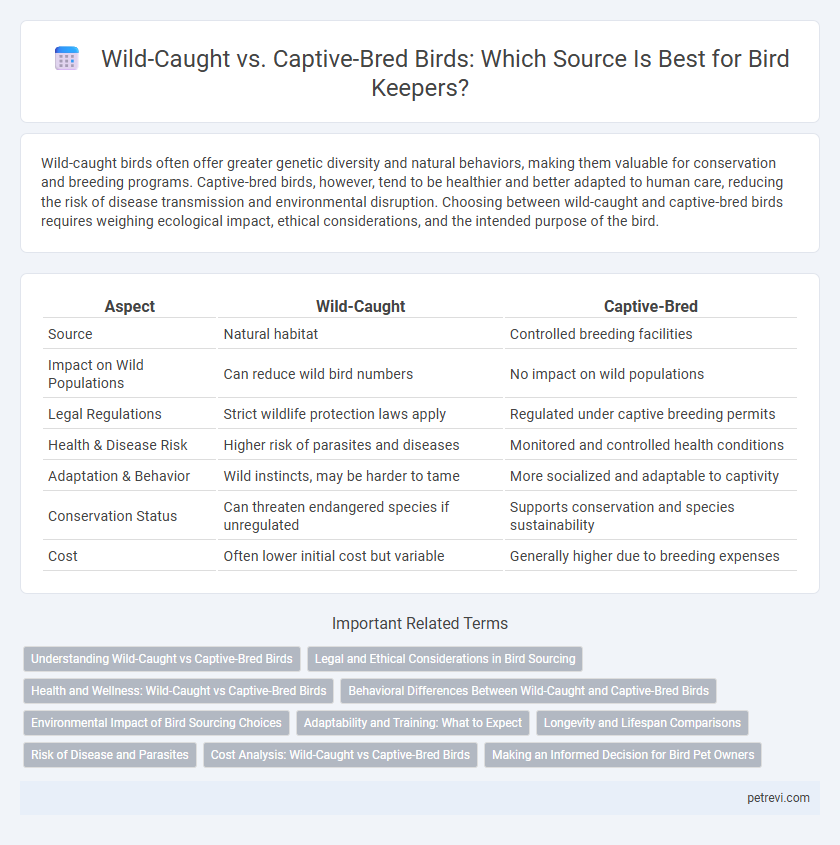Wild-caught birds often offer greater genetic diversity and natural behaviors, making them valuable for conservation and breeding programs. Captive-bred birds, however, tend to be healthier and better adapted to human care, reducing the risk of disease transmission and environmental disruption. Choosing between wild-caught and captive-bred birds requires weighing ecological impact, ethical considerations, and the intended purpose of the bird.
Table of Comparison
| Aspect | Wild-Caught | Captive-Bred |
|---|---|---|
| Source | Natural habitat | Controlled breeding facilities |
| Impact on Wild Populations | Can reduce wild bird numbers | No impact on wild populations |
| Legal Regulations | Strict wildlife protection laws apply | Regulated under captive breeding permits |
| Health & Disease Risk | Higher risk of parasites and diseases | Monitored and controlled health conditions |
| Adaptation & Behavior | Wild instincts, may be harder to tame | More socialized and adaptable to captivity |
| Conservation Status | Can threaten endangered species if unregulated | Supports conservation and species sustainability |
| Cost | Often lower initial cost but variable | Generally higher due to breeding expenses |
Understanding Wild-Caught vs Captive-Bred Birds
Wild-caught birds are captured directly from their natural habitats, often leading to stress and disruption of local ecosystems. Captive-bred birds are raised in controlled environments, promoting better health, acclimation to human interaction, and reducing pressure on wild populations. Choosing captive-bred birds supports conservation efforts and ensures more sustainable and ethical sourcing practices.
Legal and Ethical Considerations in Bird Sourcing
Wild-caught birds often face stringent legal restrictions due to conservation laws such as the CITES agreement, which regulates international trade to prevent species endangerment. Captive-bred birds, being bred in controlled environments, generally comply with legal standards and reduce the risk of depleting wild populations, aligning with ethical practices in wildlife preservation. Ethical sourcing prioritizes the welfare of birds and biodiversity protection, emphasizing transparency in provenance and adherence to wildlife protection regulations.
Health and Wellness: Wild-Caught vs Captive-Bred Birds
Wild-caught birds often face higher risks of parasites, diseases, and stress-related health issues due to their unpredictable natural environment and capture process. Captive-bred birds typically benefit from controlled conditions, regular veterinary care, and balanced nutrition, which promote better overall wellness and longevity. Health monitoring and preventive care in captivity reduce the likelihood of infections, making captive-bred birds generally healthier compared to wild-caught counterparts.
Behavioral Differences Between Wild-Caught and Captive-Bred Birds
Wild-caught birds often exhibit heightened flightiness, natural foraging behaviors, and heightened wariness due to their exposure to natural predators and diverse environments. Captive-bred birds tend to show reduced fear of humans, increased socialization, and more predictable behavior patterns resulting from controlled breeding and consistent interactions. These behavioral differences significantly impact adaptability, training ease, and long-term welfare in aviculture.
Environmental Impact of Bird Sourcing Choices
Wild-caught birds often disrupt local ecosystems, leading to habitat degradation and population declines in native species. Captive-bred birds reduce pressure on wild populations and contribute to species conservation by minimizing ecosystem disturbance. The environmental impact of sourcing choices directly affects biodiversity preservation and ecological balance in bird habitats.
Adaptability and Training: What to Expect
Wild-caught birds often exhibit heightened adaptability to natural environments but can present challenges in training due to stress and unaccustomed human interaction. Captive-bred birds generally adapt more readily to domestic settings and display increased receptivity to training methods, benefiting from early exposure to human care. Understanding these differences is crucial for optimizing bird care and ensuring successful integration into home or rehabilitation settings.
Longevity and Lifespan Comparisons
Wild-caught birds often exhibit stronger immune systems and longer lifespans due to natural adaptation, but face higher initial mortality rates from capture stress and environmental factors. Captive-bred birds typically have more predictable health outcomes and potentially extended longevity under controlled care, yet may lack the genetic robustness of wild counterparts. Lifespan comparisons highlight the trade-off between natural resilience and the benefits of managed environments in bird sourcing.
Risk of Disease and Parasites
Wild-caught birds often carry a higher risk of transmitting diseases and parasites due to exposure to diverse pathogens in their natural environment. Captive-bred birds typically undergo health screenings and controlled breeding conditions, reducing the likelihood of disease transmission. Choosing captive-bred birds minimizes the spread of zoonotic infections and promotes better overall health management.
Cost Analysis: Wild-Caught vs Captive-Bred Birds
Wild-caught birds often incur higher costs due to legal permits, transportation, and health risks, whereas captive-bred birds typically have lower acquisition expenses and reduced quarantine fees. Captive breeding allows for predictable pricing and steady availability, minimizing unexpected financial burdens linked to wild sourcing. Long-term care costs can be higher for wild-caught birds due to stress-related health issues, making captive-bred birds a more economical choice for sustainable bird sourcing.
Making an Informed Decision for Bird Pet Owners
Choosing between wild-caught and captive-bred birds impacts pet health and conservation efforts; captive-bred birds generally exhibit better acclimation to domestic environments and lower risk of disease transmission. Wild-caught birds, often subject to stress and habitat disruption, can carry parasites and face higher mortality rates, raising ethical and ecological concerns. Pet owners should prioritize species survival status, legal regulations, and sourcing transparency to make an informed, responsible decision.
Wild-Caught vs Captive-Bred for Bird Sourcing Infographic

 petrevi.com
petrevi.com